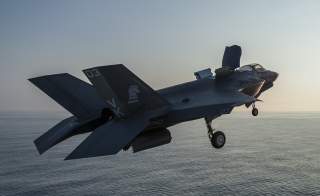5 Ways the Navy Will Beat Any Nation in a War
It’s worth noting that the Navy is currently on the cusp of a technological revolution, with new ships, fighters, radars, lasers, railguns and unmanned systems on the horizon. In ten years, a repeat of this list may look very different.
The Ohio submarines fired their first missiles in anger on March 19th, 2011 during Operation Odyssey Dawn. USS Florida fired 93 Tomahawks against Libyan military targets. In the future, the cruise missile submarines could be used as mother-ships for Unmanned Underwater Vehicles (UUVs.)
The United States Navy is the largest and most advanced navy in the world, fielding everything from aircraft carriers and maritime patrol aircraft to submarines, destroyers and unmanned helicopters.
So when your editor asks you to choose the Navy’s five most lethal weapons systems, your most difficult challenge is trying to narrow it down to just five selections. For this article I bypassed the larger platforms such as the aircraft carriers and amphibious assault ships. To be sure, those are actually the most lethal weapons in the Navy’s arsenal, however, everybody knows them, and, as big platforms, they are actually the sum of many smaller ones.
(This first appeared in 2014.)
Instead, I wanted to highlight platforms that were outstanding in some particular way, with an emphasis on the biggest bang for the buck. I also wanted to spread out the selection; it’s easy to merely include surface ships and submarines, ignoring aircraft and certain missions.
Recommended: What Will the Sixth-Generation Jet Fighter Look Like?
Recommended: Imagine a U.S. Air Force That Never Built the B-52 Bomber
Recommended: Russia's Next Big Military Sale - To Mexico?
Before proceeding, it’s worth noting that the Navy is currently on the cusp of a technological revolution, with new ships, fighters, radars, lasers, railguns and unmanned systems on the horizon. In ten years, a repeat of this list may look very different.
Arleigh Burke-class Guided Missile Destroyer:
Named after the legendary World War II admiral, the Arleigh Burke class destroyers are some of the most balanced, capable ships fielded by any modern navy. The Burke class is the backbone of the fleet, with some 62 vessels comprising over a fifth of all the ships in the Navy.
The heart of the Burke’s combat systems is in its Aegis radar system, which is capable of directing a variety of air defense missiles against incoming targets. Aegis can coordinate the defense of an entire naval surface group, and with the new Cooperative Engagement Capability the Burkes can fire on targets at extended ranges using targeting data from platforms such as the E-2D Hawkeye.
The Burke class is also capable of launching Evolved Sea Sparrow air defense missiles against short and medium range targets, and SM-2 and SM-6 missiles against long-range aerial targets. Many destroyers also have a ballistic missile defense capability, and can launch SM-3 missiles specialized for engagement of ballistic missiles.
For anti-submarine warfare, the class has a built-in SQQ-89 sonar system, with a towed sonar system scheduled for future upgrades. The ship mounts six Mk.46 anti-submarine torpedoes. The ship’s embarked MH-60R anti-submarine helicopters provide long-range anti-submarine capability, although only later versions of the Burke class were built with hangars.
For a modern ship, the Burke class is heavily armed with conventional guns. A 5-inch, 127-millimeter gun is mounted on the bow, capable of anti-ship, shore bombardment, and even a limited anti-air role. Two 25 mm guns and four .50 caliber machine guns were added after the suicide attack on the USS Cole in 1999. Finally, each ship has two Phalanx 1B close-in weapon systems designed to shoot down incoming missiles, but capable of firing on helicopters, UAVs, and small boats as well.
One area where the Burke class comes up short is in its ability to engage enemy ships. The ships are anemic in their anti-ship capability, with only older vessels even fielding 8 aging Harpoon anti-ship missiles. This has been by design, as no credible surface threat has existed and the Navy has concentrated on the Global War on Terror mission. Missiles such as the Norwegian Naval Strike Missile and the Lockheed Martin Long Range Anti-Ship Missile are in development and hold great promise as a future anti-ship missiles of the fleet.
The ships will likely be the longest class in production ever fielded by the U.S. Navy; Arleigh Burke herself was commissioned in 1991, and production is expected to continue for another fifteen years. That would mean nearly 40 years of near-continuous production for a single type of destroyer.


